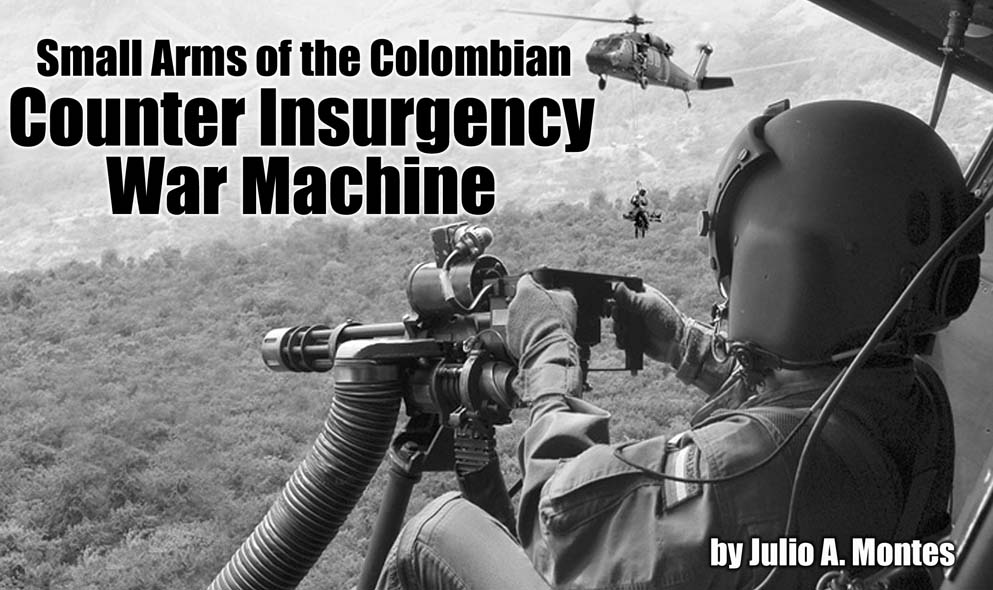By Julio A. Montes
The Colombian attack on February 29, 2008, against the FARC Front 48 stronghold, some 1,800 meters to the south of the Putumayo river, in Santa Rosa – and inside Ecuadorian territory – caught the rebels by surprise, and resulted in the fall of Luis Edgar Devia (aka Raul Reyes), a leader of the FARC directorate. Along with the body of Raul Reyes, the Colombian government captured a number of laptops with all sorts of intelligence information to include correspondence between the insurgents and Hugo Chavez in Venezuela, and their contacts in Ecuador. This victory was followed by the announcement in May that Manuel Marulanda Vélez “Tirofijo” (real name Pedro Antonio Marín), founder of the FARCs and its maximum leader, was dead. A few days before, Nelly Avila Moreno, aka Karina, another member of the FARC directorate, had been taken into custody.
To continue the fight, in April 2008 the government specified that the upcoming budget would provide 37,000 new soldiers between the previous 2007 and 2010 numbers. The budget also allows for 8,000 new rifles for a total of 13,000 small arms, and 185 gun trucks to be acquired between May and November of 2008. More helicopters are expected for added mobility around Guaviare, Guainía and Vaupés, and the police will receive 511 new motorcycles.
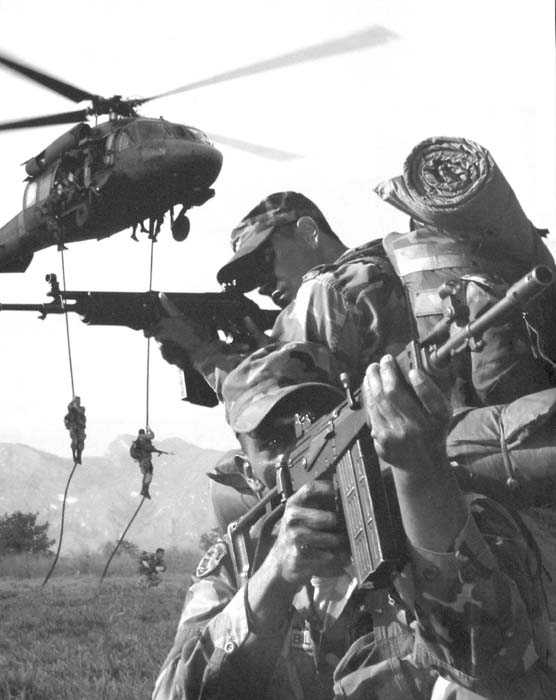
The Colombian Army, with considerable assistance in particular from the US and the British, and Europeans and Israel in general, has become a well equipped and trained force. Equipment comes from Indumil (short for Military Industries) with three main installations: General José María Córdoba Factory manufacturing small arms, particularly the Galil rifle under IMI (now IWI) license; Antonio Ricaurte Factory producing projectiles and explosives; and Santa Bárbara Factory producing ammunition. The arsenal is diversified and abundant.
In 1989 the armed forces received the first 2,020 examples of the Model 92FS (Beretta M9), which is the standard sidearm along the superb CZ75B. Some Browning HP pistols are still encountered, and the Glock 17 and Jericho 941 are also seen in operations along the locally produced Indumil Scorpio. Squad officers observed in Bogotá carried the MP5 submachine gun, and certainly the HK product is seen in all its variants: MP5A2, MP5A5, MP5A5NF, MP5SD3 and MP5K, particularly in the hands of elite forces. Some units took the Colt SMG in 9mm.
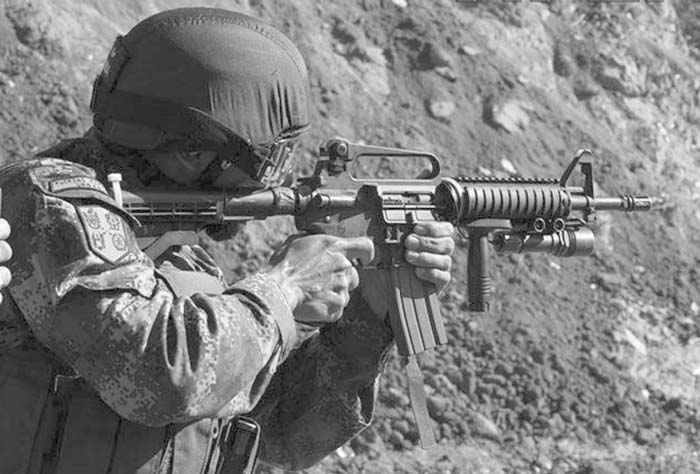
The obsolete M1 Garand was eventually replaced in the 1970s with the G3 rifle, with some 30,000 purchased in the G3A3 and G3A4 variants, along with PSG-1 with Hensoldt scope for precision work, and the HK21 for squad support. In the 1980s the Colombian government selected the Galil rifle to replace the G3, purchasing some 100,000 models in 7.62mm caliber. Starting in 1996, Indumil acquired licensed production rights, and by 2005 production had changed to the Galil SR/AR/MAR 5.56mm and variants. The conversion of all 7.62mm models to the standard 5.56mm was also implemented. The National Police receives the Galil semiautomatic-only version. The transfer of technology started with Indumil purchasing the required machinery to produce the rifle and dispatching a technical team to Israel. Israel Weapons Industry (IWI) also dispatched technicians to Colombia to assists in the setting up production. The manufacturing of the Galil in country saves around US$40 million a year in government revenues. Ironically, Israel is now purchasing the rifle from Colombia since IWI has ceased production in favor of the Tavor, and Colombia has become the sole producer of the Galil since 2006. Two years later, Indumil had increased the manufacturing of the Galil rifles to 42,000 examples a year, and it has increased the annual production of 5.56mm cartridges to 61 million.
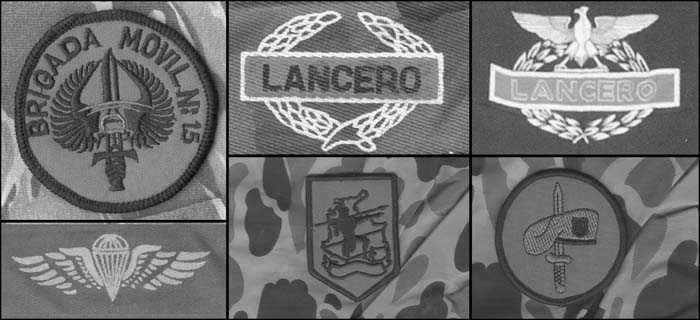
More recently, the Army has been receiving the Tavor TAR-21 and CTAR-21 with MIL-STD-1913 sight rail incorporated. The US has been supplying M16A1 and M16A2s with the first 1,126 acquired in 1990. The Military Forces have received in excess of 4,358 M16A1 Carbine, M16A2 Commando, M4, and M4A1, and more than 16,468 M14 rifles. US assistance also delivered more than 243 M24 and M40A1 sniper rifles starting in 2003. The Military Forces started receiving the Barrett Model 82A1M in 2005, and has incorporated USAS-12 and Model 870P shotguns.
The HK21 has been replaced with the M249A1, Vektor S77 and Negev light machine guns for squad support, and is complemented with some MAG-58 types. The M60 is universally used since 1985, to include the M60D in pedestal mounts in helicopters. Over 1,000 M60E3s have been received since 1985, along with over 800 M60E4 examples. The US delivered more than 650 M79 grenade launchers and in excess of 450 M203 models. Additional M203s came from Turkey, and Indumil now produces it as well. The Army makes considerable use of the RBG-6 MGL, a Croatian copy of the Milkor model, and the MGL MK1, both using the 6-round revolver type system.
The local Indumil produces the M26 and M67 defensive grenades. While the light antitank weapon arsenal includes M72A3 models, there are also Russian types such as RPG-7V, RPG-16 Udar, RPG-22 Neto and RPG-27 and RPG-29. Some elite units have received the AT4 and Carl Gustaf M3, and the Naval Infantry uses the Intalaza C-90 and Apilas. Support comes from MK19 Mod 3 MGLs, mounted on pedestals, and GAU-17/A, GAU-19/A, M134, and Chain Gun machine guns mounted on helicopters. For heavier support, the military counts with the Browning AN-M2, M2HB, and M3.
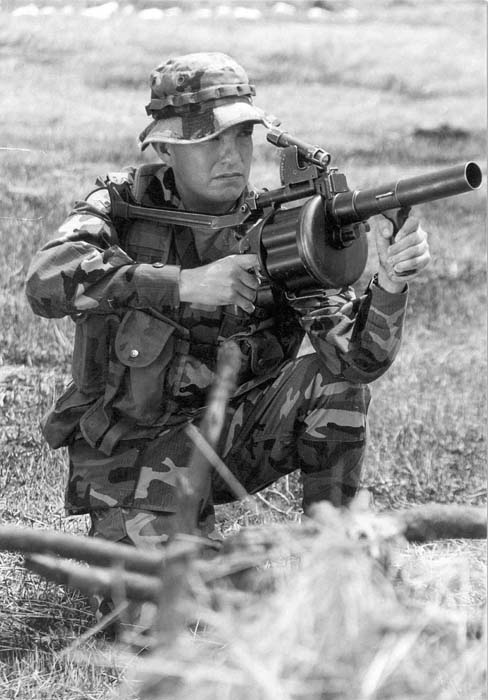
Local factories produce 100-pound and 125-pound bombs of local design as well as modern radio communication equipment. The government has contracted for the delivery of some 12,000 HE rounds for 155mm howitzers, along with some 4,000 rounds for 120mm mortars. IWI has also provided and facilitated the production of a 60mm commando light mortar and the military has cranked up local production of ammunition for its Mod-L (ECIA), MO-60, L-4, Vektor-M1, IMI-C03 Commando, IMI-C06, IMI-C08, M2, and M19 light mortars in 60 and 81mm and 40mm grenade launchers. The government has acquired 38 HY-12 Makina 120mm mortars to replace older models.
The purchases of weapons from Israel have continued, including the first 5 launchers for 50 Spike antitank missiles. These now operate along with Nimrod and TOW types, while the ground troops receive support from M40A1 in 106mm. These recoilless rifles have proved extremely effective, so it is only a matter of time before these elderly weapons are completely modernized to supplement the most modern missiles. Although the 106mm projectile is still effective against most armor, there is no need at this time for anti-armor support. The M40A1 is more useful and economical than sophisticated hardware in the anti-personnel role and against built-up areas as counter ambush weapons and against machine gun nests. IWI has already assisted in the modernization of M40A1 in Chile, and a similar project could be implemented in Colombia, adapting laser telemetry, IR and thermo sights for use day-night-any-weather-any-time. In fact, the local industry could do it thorough Coctemar (autonomous shipyard consortium) and has already developed the Jeyur weapons systems. The Jeyur, named after a deadly Colombian scorpion, consists of a weapons pedestal containing the same sophisticated equipment mentioned above to direct and accurately fire, by remote control, heavy machine guns and grenade launchers in small riverine naval combatants in any weather or conditions.
The Infantry goes to combat in the new uniform in “pixel” camouflage, developed by the No.1 Quartermaster Battalion “Juanas” in “woodland” green and khaki desert tones. The uniform was first distributed along units of the X Division, Omega Task Force, Special Forces, commandos, counter-guerrilla and pipeline security units. All web gear is also designed and produced in country, and most soldiers appear to prefer the assault vest with two large breast pouches at each side.
Lanceros: Loyalty, Valor and Sacrifice for Colombia
Spearheading the government efforts are the Lanceros. The term refers to the Colombian Rangers, and its origins are found as part of a small unit raised in 1819, and a derivative of the word “spear” in Spanish. In 1959, the Colombian Army organized several Lancero Companies to take the fight to the jungle. These were re-organized into counter-insurgency platoons in 1966 with the purpose of making them more agile and flexible. As the demand for the Lanceros’ skills increased, these experts were assimilated into the new hunter, and counter-guerrilla battalions. The Lanceros were reintegrated once more around 2004 with the establishment of the reinforced battalion, known as Lancero Group (AGLAN); they live for loyalty to their superiors, comrades, subordinates, the institution, and the motherland; they demonstrates valor to deal with all the difficulties found in the field, and each Lancero sacrifices his needs for the benefit of the force. These three simple words define a Colombian Ranger.
The AGLAN, along with the BACOA (Commando Battalion), form the direct action forces of the Army Special Operations Command (COESE). In addition, this command also comprises the Army Special Commando (CEE), an anti-narcotic team, working along with the Army Intelligence Operations Center (CIME) and the Colombian Technical Intelligence Center (CITEC).
The Lanceros School (ESLAN) notoriety was earned as a result of producing one of the finest jungle fighters in the continent. Between 1955 and 2005, the school held 284 classes, producing 10,000-jungle experts; add a couple of thousand more by now. ESLAN was established by Decree No. 3155 on December 6, 1955, and was led by a group of officers who had attended and graduated from the US Ranger Course. The instructors adapted the techniques and tactics learned in the US to the Amazon jungle environment typical of Colombia, and thus evolved into one of the most prestigious counter-insurgency training establishments in South America.
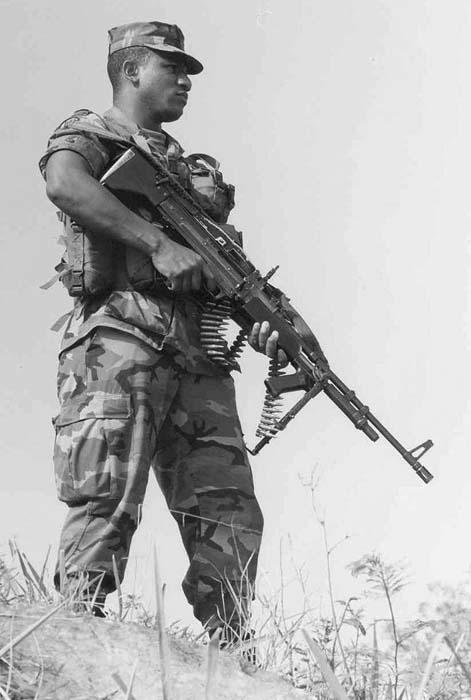
Without a doubt, the most grueling part of the Lancero Course is the jungle class. This now takes place at the Amazon II Fort, with the three-day survival part of it taking place at Ronda Island, in the middle of the Amazon River. The jungle class takes two weeks, and it is the last of about two and one half months of intensive training designed to create motivated and well skilled leaders of small units ready to fight in any kind of terrain. In here they will learn that the guerrillas are likely to booby trap branches, so picking up fruits from the trees to eat during the duration of the class is forbidden. Therefore, the local cuisine calls for learning to eat the mojojoy (between other things) a worm found in the palm tree-trunks. It helps to mentally prepare for them by naming them “jungle shrimp” (if it sounds better, maybe it tastes better). The class will culminate with the “Death March” where the candidates will have to cover in full gear all 36 kms separating the Amazons II Fort from Leticia City. Those who make it receive the emblem typical of the Lanceros and the black beret.
A Lancero starts his training with a Preparatory Phase lasting two weeks. The candidate reviews field hygiene, communications, basic small arms, and planning. The phase is complemented with another class dedicated to developing resistance, evasion, escape, and survival skills (REES – in Spanish). Here the candidates prepares physically, tactically and mentally for the next phase.
The following phase is called Complementary Phase. The first three weeks of this phase are spent at the Lancero Training Center in Tolemaida, learning jungle warfare tactics, and a few days spend at Icononzo, Tolima, in platoon leadership skills. At the end of the 7th week, the class will move to the Jungle Training Center at Amazonas II Fort, where they will spend their last two weeks of training. Most elements of other elite forces have attended the Lancero training at one point or another.
AFEAU + AFEUR
The national intervention unit is the Antiterrorist Urban Special Forces Group (AFEAU), found under the Colombian Special Forces Command (CCOPE). The AFEAU was established in April 8, 1985, and it comprises four teams, each with 2 officers and 13 commandos selected from all four branches of the military (Army, Air Force, Navy and Police). The AFEUR, on the other hand, refers to twelve Army Urban Special Forces Groups distributed among the seven Army Divisions for local antiterrorist tasks. Given the name, there is considerable confusion between the AFEAU and the AFEUR, even in official documents. Each AFEUR is divided in six squads of 15 men. In addition, each brigade deploys a GAES, or Anti-Extortion and Anti-Kidnapping Special Group.
The Army Rural Special Forces Brigade (BRFER) deploys three Special Forces battalions (BFER2, BFER3 & BFER4), from Tolemaida, and also is associated to the FUDRA. This is the Rapid Reaction Force established on December 7, 1999, at Tolemaida Fort, with the 1st airmobile brigade (BRM01), BRM02 and BRM03. By 2008, the Army had organized 21 mobile brigades, each comprising 1,287 soldiers divided into 4 counter-guerrilla, one support and services and one headquarters battalions. There are several jungle brigades, such as the 22nd, 26th, 27th, 28th and the 43rd.
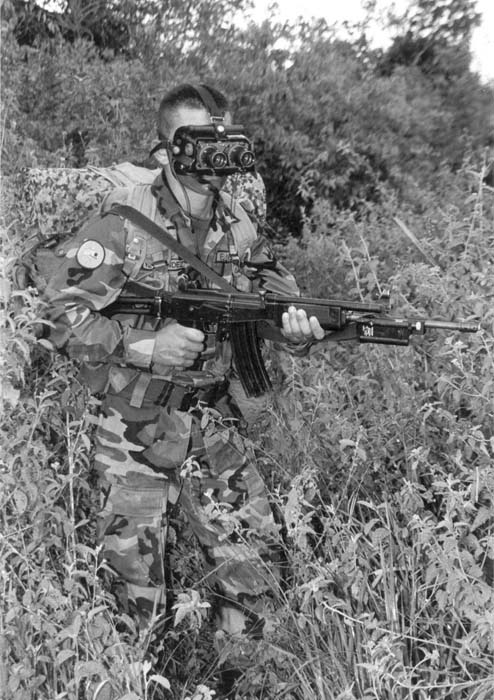
The Counter-Narcotics Special Forces Brigade (BRCNA) became active on May 14, 2000 and immediately deployed to Putumayo, and then to Larandia (Caquetá) to fight narco-guerrillas and drug runners. Today, the BRCNA deploys the following counter-narcotics battalions: BACNA1, BACNA2, and BACNA3, supported by BASCN (logistical support battalion), and all operating from Larandia. The BRCNA has been trained and equipped by USSF.
Starting on March 22, 2001, the Colombian Army deployed its first of seven or eight high mountain battalions, trained under the supervision of the British SAS. Each battalion aligns 30 officers, 566 soldiers, 193 specialist and NCOs and 7 civilians. Finally, as part of the Army element we mention the little known Matamoros Mechanized Group, X Armored Brigade, which corresponds to the desert commandos. The Group is based at La Flor, and operates in long range mobile patrols using motorcycles (called Scorpions), SOV Humvees, SOV Abir pickups, EE9 Fire Support vehicles and EE11 armored transports, patrolling an area of 11,000 square kilometers.
Other military elites
Since 2004, the Air Special Commando Group (ACOEA) provides base security and Csar support for the Air Force.
The Colombian Marine Corps is considered an elite element of the military, fielding one regular Marine and two river warfare brigades; however, the 1st Marine Special Forces Battalion (BFEIM) provides for dedicated special operations tasks. BFEIM operates from Cartagena, deploying counter-guerrilla battalions, two Nav Afeur and the Northern Naval Special Dive Unit (UBEN – Unidad de Buceos Especiales del Norte). Another specialized outfit little known outside Colombia is the Submarine Commando Group (Grupo de Comandos Submarinos), equivalent to the US Navy Seals, and charged with covert operations along the Colombian, and also any other, coastal area. Their main “toy” is the Chariot SDV. Three of these are operational, and are named Arc Defensora, Arc Poderosa and Arc Protectora. These vehicles allow two combat scuba divers to infiltrate enemy positions. Like the Seals, these commandos train in all sort of conditions, and have developed a number of techniques for interdiction, in-mobilization and boarding of go-fast boats. Each Unit comprises two officers and five Marine NCOs. The Navy does not release much information on how many Units form the Group, but it is known that the Submarine Commando School has graduated 23 operators since its recent establishment. These naval commandos operate in tandem with those men assigned to the Cosmos midget submarines operated by the Navy. They also have close ties with the Amphibious Commando Group, which would be the Colombian equivalent to a 100-strong Recon Company. The Group is divided in four platoons of 25 operators, and they are in charge of reconnaissance operations for the Colombian Marines. The Navy and its Reconnaissance and Assault Group (GREAS), trained by US and British commandos, are tasked with validating intelligence dealing with illicit fast boat operations and boarding operations.
(The Author is grateful for the assistance and cooperation received from the Assistance Integral Office of the Colombian Army, CAN.)
| This article first appeared in Small Arms Review V12N3 (December 2008) |



